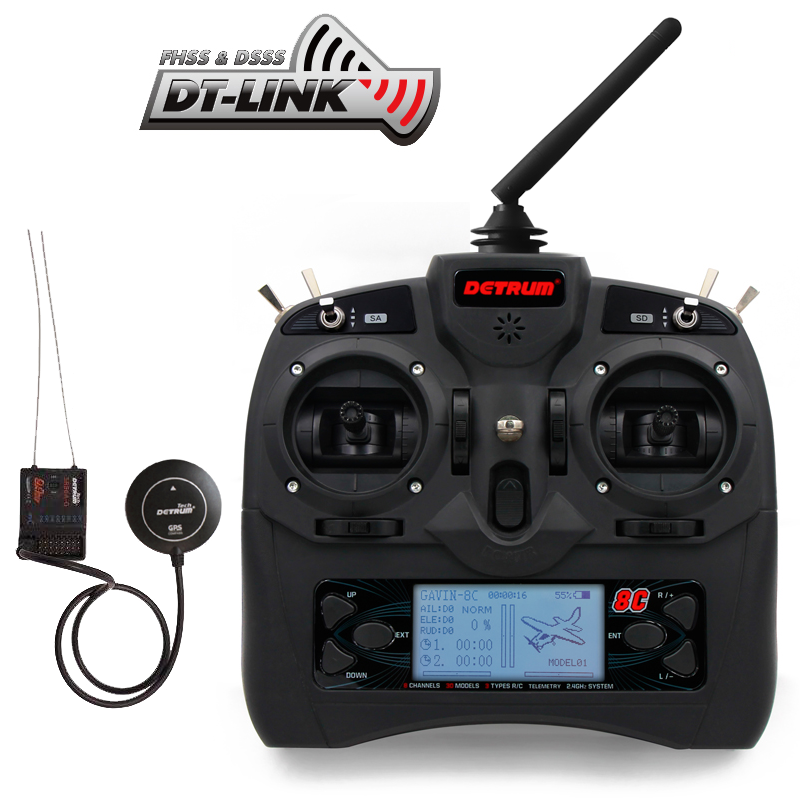When it comes to remote-controlled (RC) hobbies, choosing the right receiver and transmitter (commonly referred to as radio or radio system) is crucial, especially for beginners. With the plethora of options available, it can be overwhelming to find a reliable system that meets your needs. In this article, I’ll share my insights on what to look for in a reliable RC receiver transmitter, drawing from my experience with the Detrum GAVIN-8C 8CH Digital Transmitter and SR86A-G GPS Autopilot Telemetry Receiver.
Understanding the Basics of RC Systems
Before diving into the specifics, it's important to understand how RC systems work. At its core, an RC system consists of two main components: the transmitter (handheld remote) and the receiver (mounted in the model). The transmitter sends control signals to the receiver, which interprets these signals and relays them to the servos and motors of your RC vehicle or aircraft.
Key Features of a Reliable RC Receiver Transmitter
-
Signal Range
- A reliable system should have a good range to ensure you can operate your RC vehicle without losing control. Generally, for beginners, a range of at least 300 meters is recommended.
-
Frequency Band
- Most modern RC systems operate on the 2.4 GHz frequency, which offers good range and reduced interference. Always check for compatibility with your model.
-
Channel Count
- More channels mean more controls for various functions. For beginners, a 4 to 6 channel transmitter is usually sufficient, but as you advance, you might want an 8-channel system, like the Detrum GAVIN-8C.
-
User-Friendly Interface
- A simple and intuitive interface is vital for beginners. Look for systems with clear displays and easily accessible controls.
-
Telemetry Features
- Telemetry allows you to receive real-time data about your model's performance, such as battery voltage, signal strength, and more. The Detrum SR86A-G offers this feature, enhancing your flying experience.
-
Build Quality and Durability
- Since RC hobbies can be rough, ensure that your receiver transmitter is built to withstand occasional crashes or harsh conditions.
My Experience with the Detrum GAVIN-8C and SR86A-G
As a beginner, I initially faced challenges in selecting a reliable RC system. However, after researching, I settled on the Detrum GAVIN-8C 8CH Digital Transmitter paired with the SR86A-G GPS Autopilot Telemetry Receiver. Here are some of the reasons why I found this setup ideal for someone just starting out:
Ease of Use
The Detrum GAVIN-8C features a straightforward layout with clearly labeled buttons and an LCD screen that makes it easy to monitor settings. Setting up was a breeze, allowing me to focus more on flying and less on fiddling with complicated controls.
Impressive Range and Performance
With a range exceeding 1 km, I felt secure operating my RC aircraft from a distance. The signal remained strong even in challenging environments, allowing me to explore new flying locations without fear of losing control.
Telemetry Data
The telemetry features provided invaluable information. For instance, I could monitor battery levels in real-time, ensuring I always had enough power to safely return home. This feature was particularly beneficial when I was still learning to judge flight times.
Durability
During my initial flights, I had a couple of minor crashes. Thankfully, the GAVIN-8C showed no signs of damage, demonstrating its robust design. The receiver also withstood the elements, giving me confidence to fly in various weather conditions.
How to Choose the Right RC Receiver Transmitter
Here’s a concise table to summarize the key features and considerations when selecting a reliable RC receiver transmitter:
| Feature | Importance | Recommended Level |
|---|---|---|
| Signal Range | Essential for safety | At least 300 meters |
| Frequency Band | Minimizes interference | 2.4 GHz |
| Channel Count | Flexibility in controls | 4-8 channels |
| User Interface | Ease of operation | Simple and intuitive |
| Telemetry Features | Real-time data monitoring | Yes, for better control |
| Build Quality | Durability | Robust and weatherproof |
FAQs About RC Receiver Transmitters
1. What is the difference between a transmitter and a receiver?
The transmitter is the handheld device you use to control your RC vehicle, while the receiver is mounted within the vehicle to receive signals from the transmitter and translate them into movement.
2. How do I know if my transmitter and receiver are compatible?
Most modern systems operate on the same frequency (2.4 GHz), but it’s essential to check the specifications provided by the manufacturer to ensure compatibility.
3. Can I upgrade my transmitter or receiver later on?
Yes, many hobbyists start with a basic system and upgrade to more advanced models as they gain experience. Make sure to check compatibility with your existing equipment.
4. How do I perform basic troubleshooting if my system isn’t working?
Check the following:
- Ensure the batteries in both the transmitter and receiver are charged.
- Verify that the transmitter is bound to the receiver.
- Inspect for any physical damage or loose connections.
Conclusion
Selecting the right remote control transmitter receiver is pivotal for a successful and enjoyable experience, especially for beginners. With key features like range, durability, and user-friendliness, systems like the Detrum GAVIN-8C and SR86A-G offer an excellent balance of performance and ease of use. By considering the factors outlined in this guide, you’ll be well on your way to making an informed choice that will enhance your RC adventures.

Comments on “What Makes a Reliable RC Receiver Transmitter for Beginners?”